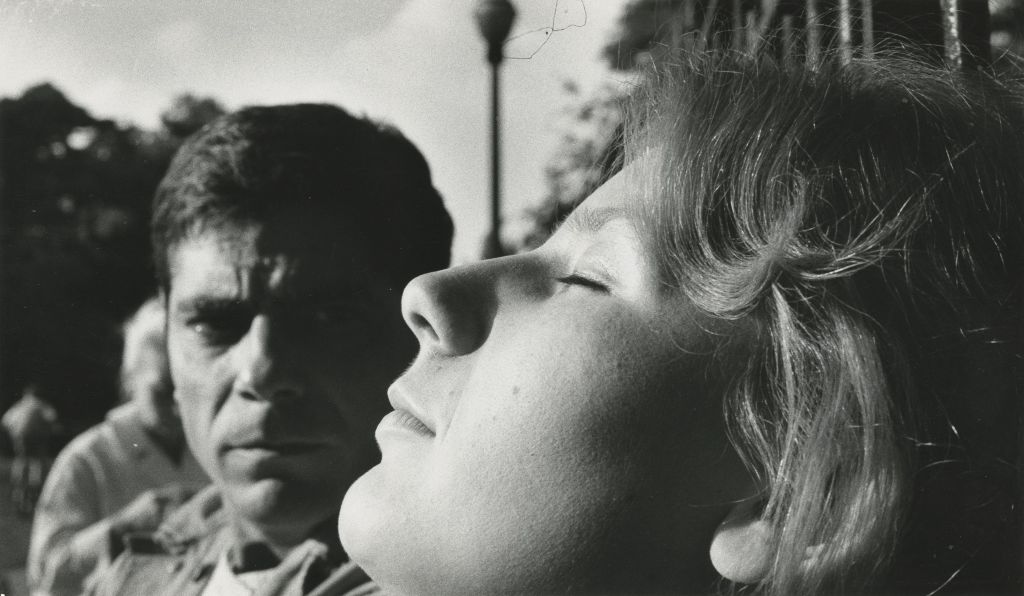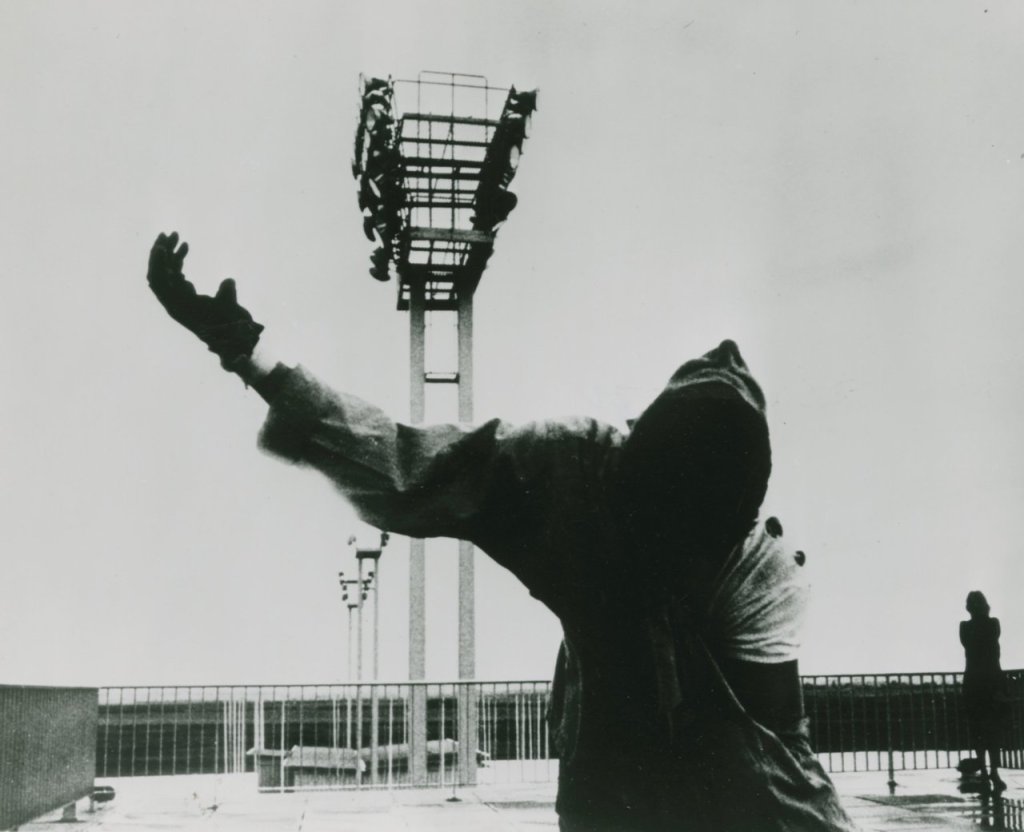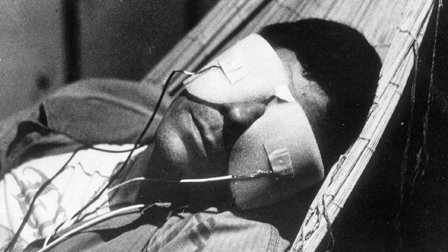I hate Stella Artois. Somehow, I always end up with a glass of it at parties where I try too hard to fit in. Keenly aware that even Stan Brakhage’s work would be met with disinterest by this crowd, I drank up. A week earlier, I, along with some other filmmakers had been invited to this event which would announce the final programming lineup of The Atlanta Film Festival. The event organizers also gave us a chance to promote our films, and now it was my turn to promote my video New Radiant, the only experimental film featured that night. As I stood at the microphone, I drank in the vastness of the beer soaked crowd and froze. From that point on, the details are hazy. I definitely remember that the word “artist” tumbled out of my mouth as I introduced myself to the crowd of filmmakers. I also remember tripping over a shameful plug which might have included the phrase, “meditation on obsolete technologies”. As I walked back to my seat, I knew I was going to get reamed for it. And sure enough, as the next group of filmmakers promoted their zombie film, one of them described it as a “meditation on zombie culture” in a surprisingly derisive tone. Up at the microphone, the filmmakers smirked. I heard stifled laughter skitter across the room. I felt my cheeks burning as sank in my chair. As I try to place myself in a larger art (or film) world, there are times where I have been, to quote Howard Devoto, “shot by both sides”.
That I should find myself reading The Cinematic at this particular time seems strangely fortuitous, as it coincided with this film festival. The readings contained in this book imbued the entire experience with a particular insight as I struggled to reconcile these sides of art and film. At the beginning, I was struck by the way that The Cinematic editor Peter Campany broadens the cinematic beyond the obvious realm of Film Theory. Throughout the first half of the book, many of the essays meditate on photography, arguing that cinematography is either an advancement or a bastardization of it. While this may have frustrated me at first, I soon found that these articles reshaped my thoughts on what it means to be considered “cinematic”.
Anton Giulio Bragaglia’s “Futurist Photodynamism” struck a loud chord with me. Written in in 1913, in the wake of Dadaism and a burgeoning mass media, he argues that:
“We are certainly not concerned with the aims and characteristics of cinematography and chronophotography. We are not interested in the precise reconstruction of movement, which has already been broken up and analysed. We are involved only in the area of movement which produces sensation, the memory of which palpitates in our awareness. We despise the precise, mechanical, glacial reproduction of reality and take the utmost care to avoid it.”(p.25) .
Bragaglia seeks to push photography past the conventions of his day, and in his mind, sees cinematography as missing the point entirely. As an artist who seeks to test the limits of my medium, I can appreciate Bragaglia’s ethos. I believe he brings up points that are still valid, and should be considered by experimental filmmakers and photographers, alike.
As I progressed through the book, it became clear to me that the type of argument made by Bragaglia is not a new one. In the second half of the book, questions are posed about the implications of recent technologies. I found Laura Mulvey’s thoughts on the Pensive Spectator quite interesting “…new technologies” she writes,”allow the spectator time to stop, look and think. This process opens up the possibility of a link that takes the kind of theoretical reflection developed for an analysis of the still photograph to a new relevance for the moving image.” (p.135). I also found David Campany’s article on “Late Photography” amusing and insightful. He describes a BBC documentary surrounding a photographer who documented the aftermath of 9/11 trough photographing The World Trade Center’s ground zero. He writes,”The suggestion that photography,rather than television is the better medium for official history was unusual. Television was deeming itself unable to perform an image task given over to photography, even while it was showing us images at least as informative as the ones being taken by the photographer.”(p.185). Millennials are said to have “grown up” alongside the Internet. Because of this, perhaps the questions posed by Mulvey, Campany and Bragaglia, not only seemed familiar, but of imminent concern an regarding my artistic practice. Through this selection of essays, there is an apparent argument that technological advances will always keep cinema and photography in a state of flux.
The most powerful writing came in the form of Theirry de Duve’s “Time Exposure and Snapshot: The Photograph as Paradox ”. While complex in style, I also found his argument ground shifting. The way he writes about the paradoxical nature of photography reframed the way I looked at not only photography, but at cinematography. In his theory, he employs semiotics and psychoanalysis to define the very core of photography. Certainly, I am acquainted with works by the classic film theorists using this approach, but I was surprised to see de Duve read photographs with a theoretical protocol similar as that used by film theorists for cinema. de Duve finds that photography contains a paradoxical, bipolar nature, rife with friction.
“…time exposure is typical of a way of perceiving the photograph as ‘picturelike’,wheras the instantaneous photograph is typical of a way of perceiving it as ‘eventlike’. These two ways are mutually exclusive, yet they coexist in our perception of any photograph, whether snapshot or time exposure. Moreover, they do not constitute a contradiction that we can resolve through a dialectical synthesis. Instead, they set up a paradox, which results in an unresolved oscillation of our psychological responses towards the photograph.” (p.52).
de Duve writes with welcoming intelligence and personality. While his language engages the reader, there were times that I found it hard to crack. He argues that the photograph’s paradoxical nature elicits in the viewer a sense of trauma. But his presentation of this argument is so detailed, so entrenched in the ideas of Lacan and linguistics, that I had to re-read it several times. Before I admitted defeat, however, he offered an example which untangled his snarled web:
“I wish to claim that the photograph is not traumatic because of its content, but because of immanent features of its particular time and Spence,3 space..As an example, one might recall the famous press photograph from the war in Vietnam, in which we see a Saigon police officer about to shoot a Vietcong soldier…I’ll always be too late, in real life to witness the death of this poor man, let alone to prevent it; but by the same token, I’ll always be too early to witness the uncoiling of the tragedy, which at the surface of the photograph, will of course never occur…it is the sudden vanishing of the present tense, splitting into the contradiction of being simultaneously too late and too early, that is properly unbearable.” (p.57-58).
Through his intellect and charm, de Duve manages to articulate the charisma of photography which would otherwise seem inexpressible. The conflict, or friction, of simultaneously being too early and too late for the photographed event speaks to the particular allure of photography, and this idea has changed the way I look at cinema.
Peter Wollen’s “Fire and Ice” serves as both an interesting extension and counterpoint to de Duve’s piece. Wollen expands upon de Duve’s argument by also juxtaposing photography with cinema. “Photographs appear as devices for stopping time and preserving fragments of the past, like flies in amber. Nowhere, of course, is this trend more evident than when still photography is compared with film.”(p.108). Wollen views photographs as building blocks of a narrative. He states that,“Still photographs…cannot be seen as narratives in themselves, but as elements of narrative.” (p.110). Later, Wollen espouses the distinctive strengths of cinema and photography in a way which encapsulates many of the arguments found in The Cinematic anthology, for instance, “…film is like fire, photography is like ice. Film is all light and shadow, incessant motion, transience, flicker, a source of Bachelardian reverie like the flames in the grate. Photography is motionless and frozen, it has the cryogenic power to preserve objects through time without decay.” (p.111). If film is fire and photography is ice, then Chris Marker’s La Jetée mediates the two elements in a way that trumps convention.
Uriel Orlow’s analysis of La Jetée shouts back in defiance at everything in the book that precedes it. Up until this point, one could organize the arguments presented into two clearly delineated camps: cinematic or photographic. Here, Uriel Orlow describes how Marker blurred these fields in his seminal work.
“The self-confessed medium of La Jetée, the photo/cinéroman proves exactly this point, by proposing a middle ground, an undecidability between photography and cinema, which is simply defined by the presence of photographic images (moving or not) and their assemblage into a story. La Jetée defies the binary oppositions between photography’s kinship with death and film’s association with life, between past and present, the fossil and the mummy, by making use of both photographic and cinematic conventions.” (p.181)
Despite the conflict inherent in making a film with static imagery, Orlow claims that,“La Jetée does not propose a synthesis of the dialectic of photography and cinema, but rather “undoes the opposition itself and stops the dialectic in its tracks, showing time in the image independently of its medium” (p.182).
In any other volume, La Jetée might be overlooked as an aberration. But the inclusion of such an incongruous work proves a smaller point in the larger arc of The Cinematic’s argument. Sergei Eisenstein wrote that conflict is “the basis of every art…”(p.30). The written works presented in this anthology detail the conflicting relationship between Photography and Cinema in a way reminiscent of Eisenstein’s editing style.
This clash of ideas is integral to The Cinematic’s success as a critical work. The book presents a myriad of conflicts, from the theoretical ramifications of technological advancement, to artists ability to use new tools effectively. The Cinematic argues the strengths and weaknesses of photography and cinema in equal measure. Taken singularly, the essays work like shots, or cells of a montage. As Eisenstein argued, “The collision of these cells breeds conflict….from the collision of two given factors arises a concept.” (p.30).Through the clash of these ideas, Campany submits that this constant state of flux has been part and parcel with the mediums of photography and cinema since their inception.
“unprecedented change has been the very nature of modernity, which has taken film and photography, whether written in the 1920’s or last year, has ended with a prediction of great change to come. Sound, colour, television, video, digitization, the internet, along with the turns in economic and political climate have all brought crises and renewal. It is the nature of these media, if we can call them that, to remain permanently unsettled.”
After my experimental film screening at the film festival, my head exploded with reflections from The Cinematic. On the way out of the auditorium I ran into a local experimental filmmaker, and personal hero. Initially, we discussed films in the program. Then the conversation turned to frustrations over labels like “artist” or “filmmaker”. Much to my surprise, he too had grown frustrated with the term “experimental filmmaker” preferring to be defined as an “artist”. By choice, he uses film as his primary medium, but has no problems with switching to others if it suits his vision. Hearing him call himself an artist made me think back to my latest residency at Lesley University College of Art and Design, when, in conversation with a friend, it came up that one of the professors, a video artist, prefers the term “artist” instead of “filmmaker”. At the time I took it as a strange betrayal, but in listening to this local filmmaker, I finally understood her stance.
As Campany states, change exists at the very heart of modernity. Earlier I stated that I had been “shot by both sides”. Maybe there are no sides, no clearly delineated camps of art and film, of photography and cinema. A ceaseless, formless shape-shifting artistic landscape is terrifying and enthralling all at once. After reading The Cinematic, I see a moment fraught with constant change. In a situation that refuses to be defined, maybe resisting definition is the best way to survive.
Works Cited
Bragaglia, Anton. “Futurist Photodynamism.” The Cinematic. London: Whitechapel, 2007. 2532. Print.
Campany, David. “Safety in Numbness: Some Remarks on Problems of ‘Late Photography'” The Cinematic. London: Whitechapel, 2007. 18394. Print.
De Duve, Thierry. “Time Exposure and Snapshot: The Photograph as Paradox.” The Cinematic. London: Whitechapel, 2007. 5261. Print.
Mulvey, Laura. “Stillness in the Moving Image: Ways of Visualizing Time and Its Passing.” The Cinematic. London: Whitechapel, 2007. N. pag. Print.
Orlow, Uriel. “Photography as Cinema: La Jetée and the Redemptive Powers of the Image.” The Cinematic. London: Whitechapel, 2007. 17783. Print.
Wollen, Peter. “Fire And Ice.” The Cinematic. London: Whitechapel, 2007. 10812. Print.



